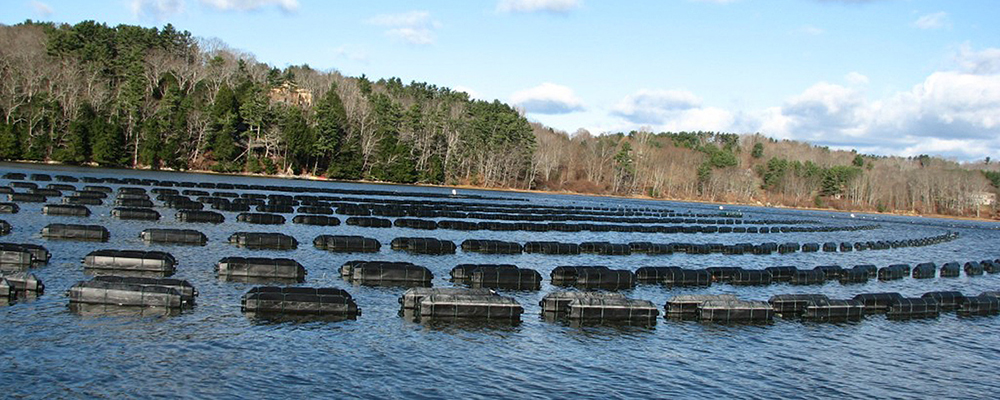
Mook Sea Farm, Wapole, Maine. Credit: Mook Sea Farm
In FY 2015, the U.S. IOOS Program (IOOS®), in partnership with NOAA’s Ocean Acidification Program, continued a multi-year Ocean Technology Transition project to advance science and technology and better enable decision making.
The Ocean Technology Transition project sponsors the transition of emerging marine observing technologies, for which there is an existing operational requirement and a demonstrated commitment to integration and use by the ocean observing community, to operational mode. Marine observation technologies include hardware and software platforms, sensors, and data transfer technologies that collect observations in the marine and Great Lakes environments. Transitioning marine observing technology to operations will result in improved ocean, coastal, and Great Lakes observing capabilities that are critical for helping us understand our ocean, coastal, and marine environments and improve environmental intelligence for environmental decision making.
As part of this effort during FY 2015, IOOS funded three projects totaling $1.2 million to accelerate the transition of marine sensor and other advanced observing technologies to operations mode. Details on each of the three FY 2015 projects follow:
-
- Deployment of an Operational System for Acquiring and Disseminating Oceanographic and Behavioral Data Telemetered from Tagged Sharks
The University Of Hawaii Institute Of Marine Biology (UH) received funds for a two year project that will initially focus on deploying environmental sensor tags on tiger sharks caught within the coverage footprint of the array but exploratory deployments will also be made with six gill and hammerhead sharks. Tiger sharks sample the water column between the surface and approximately 300 meters while six-gill sharks sample between 300 and 1000 meters. Data will be acquired via the Argos satellite system and through land-based relay receivers installed on several islands as part of this project. All relevant data will be relayed to the Global Telecommunications System (GTS) and similar databases. Previous results indicate that areal coverage will range from very nearshore out to several hundred miles from the Hawaiian Islands. New types of tags will be tested in the array as they become available from our industry partner.
Year 1 funding for this effort is $371,000.
-
Tracking Ocean Alkalinity using New Carbon Measurement Technologies (TAACT)
In collaboration with NOAA’s Ocean Acidification Program, U.S. IOOS’ Ocean Technology Transfer Project awarded the University of New Hampshire (UNH) a three year grant to expand the quantity and quality of ocean acidification (OA) monitoring across Northeastern U.S. coastal waters. In all, five different deployment platforms will be used to enhance ocean acidification monitoring within the Northeast Coastal Acidification Network (NE-CAN) with significant improvement in temporal and spatial coverage. In addition, three parameters tied to the coastal ocean’s carbonic acid system will be measured. These parameters are Total Alkalinity (TA), pH, and the partial pressure of carbon dioxide (pCO2). Adding the all-new TA measurement capability to the regional observation network will provide more accurate, certain, and reliable OA monitoring.
Year 1 funding for this effort is $300,000.
-
Transitioning Imaging Flow CytoBot for Harmful Algal Bloom Mitigation and Research
The Woods Hole Oceanographic Institution (WHOI) was awarded a three year grant to expand the Imaging Flow CytoBot’s (IFCB) potential for operational use by deploying it on autonomous vehicles in the Gulf of Maine and in the Gulf of Mexico. These deployments will enable high resolution plankton studies with both long duration and spatial coverage. The current generation IFCB and its suite of image analysis software have been in development for over 10 years. Initially conceived as an instrument that would be deployed at fixed locations, the IFCB-AV project has been designed so that the strengths of the current IFCB design are best translated to a mobile deployment platform. The project also leverages an extensive effort to transition the suite of IFCB image analysis tools to a web services design, minimizing the investment necessary for new users to take advantage of these. Expected benefits from the proposed work are improved early warning of Harmful Algal Blooms (HAB) in the Gulf of Maine and the Gulf of Mexico.
Year 1 funding for this effort is $439,730.
- Deployment of an Operational System for Acquiring and Disseminating Oceanographic and Behavioral Data Telemetered from Tagged Sharks
For more information about the Ocean Technology Transition project, please contact the Project Manager, Jenifer Rhoades at jenifer.rhoades@noaa.gov.
 Official websites use .gov
A .gov website belongs to an official government organization in the United States.
Official websites use .gov
A .gov website belongs to an official government organization in the United States.
 Secure .gov websites use HTTPS
A lock or https:// means you’ve safely connected to the .gov website. Share sensitive information only on official, secure websites.
Secure .gov websites use HTTPS
A lock or https:// means you’ve safely connected to the .gov website. Share sensitive information only on official, secure websites.
